2023 TOYOTA GR YARIS belt
[x] Cancel search: beltPage 33 of 470
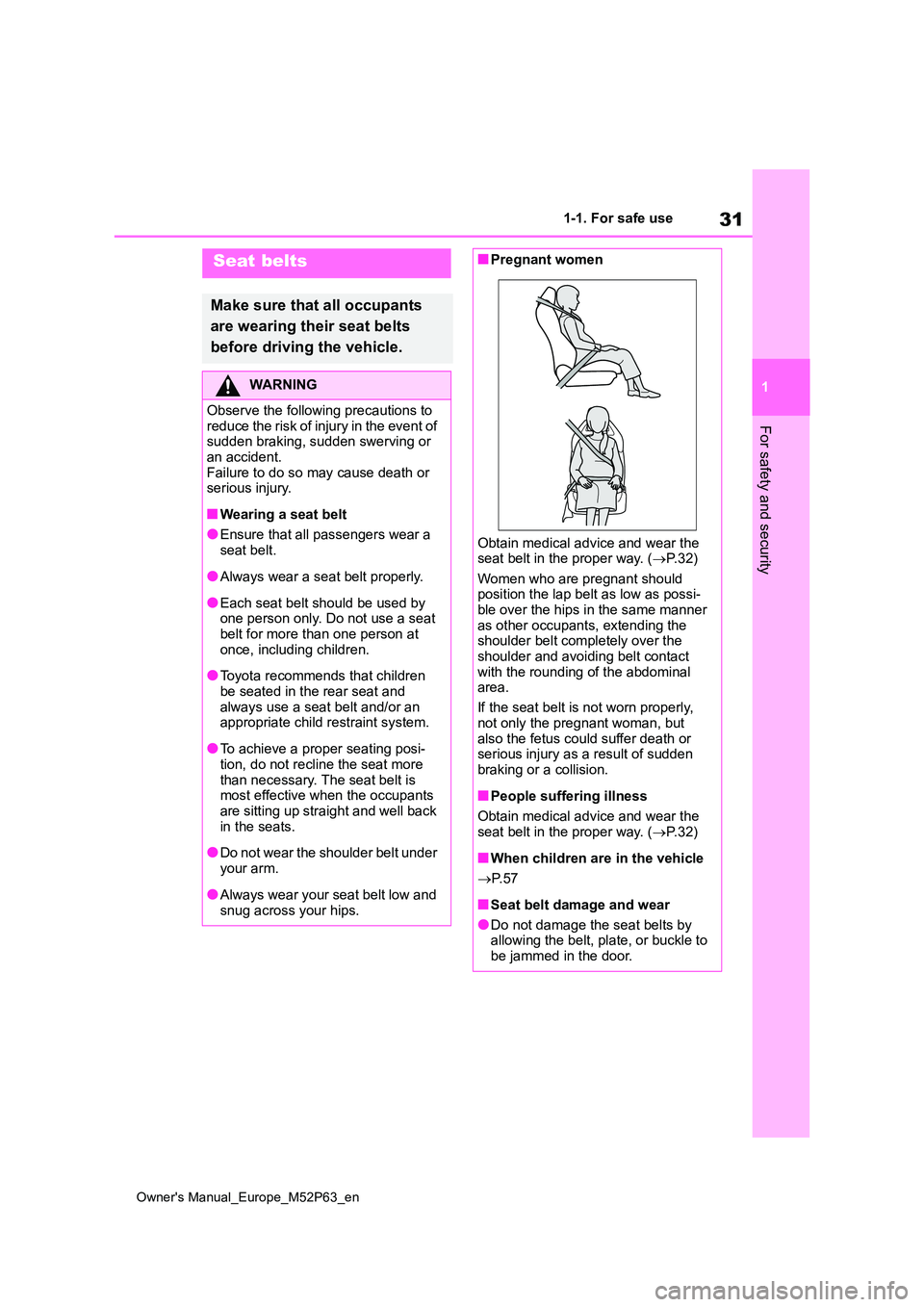
31
1
Owner's Manual_Europe_M52P63_en
1-1. For safe use
For safety and security
Seat belts
Make sure that all occupants
are wearing their seat belts
before driving the vehicle.
WARNING
Observe the following precautions to
reduce the risk of injury in the event of sudden braking, sudden swerving or an accident.
Failure to do so may cause death or serious injury.
■Wearing a seat belt
●Ensure that all passengers wear a seat belt.
●Always wear a seat belt properly.
●Each seat belt should be used by one person only. Do not use a seat belt for more than one person at
once, including children.
●Toyota recommends that children
be seated in the rear seat and always use a seat belt and/or an appropriate child restraint system.
●To achieve a proper seating posi-tion, do not recline the seat more
than necessary. The seat belt is most effective when the occupants are sitting up straight and well back
in the seats.
●Do not wear the shoulder belt under
your arm.
●Always wear your seat belt low and
snug across your hips.
■Pregnant women
Obtain medical advice and wear the seat belt in the proper way. ( P. 3 2 )
Women who are pregnant should position the lap belt as low as possi-ble over the hips in the same manner
as other occupants, extending the shoulder belt completely over the shoulder and avoiding belt contact
with the rounding of the abdominal area.
If the seat belt is not worn properly,
not only the pregnant woman, but also the fetus could suffer death or serious injury as a result of sudden
braking or a collision.
■People suffering illness
Obtain medical advice and wear the seat belt in the proper way. ( P. 3 2 )
■When children are in the vehicle
P. 5 7
■Seat belt damage and wear
●Do not damage the seat belts by allowing the belt, plate, or buckle to
be jammed in the door.
Page 34 of 470
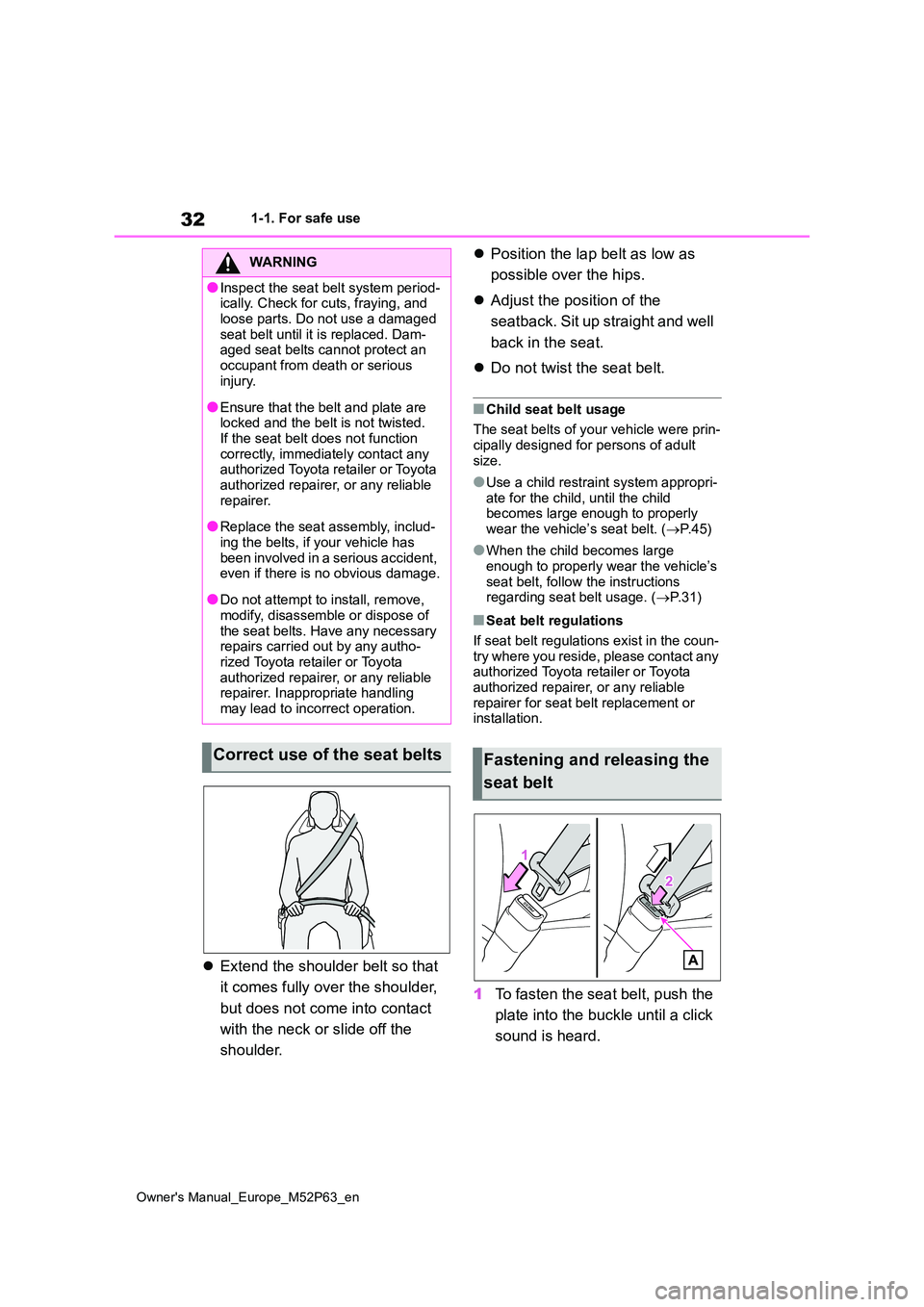
32
Owner's Manual_Europe_M52P63_en
1-1. For safe use
Extend the shoulder belt so that
it comes fully over the shoulder,
but does not come into contact
with the neck or slide off the
shoulder.
Position the lap belt as low as
possible over the hips.
Adjust the position of the
seatback. Sit up straight and well
back in the seat.
Do not twist the seat belt.
■Child seat belt usage
The seat belts of your vehicle were prin- cipally designed for persons of adult
size.
●Use a child restraint system appropri-
ate for the child, until the child becomes large enough to properly wear the vehicle’s seat belt. ( P.45)
●When the child becomes large enough to properly wear the vehicle’s
seat belt, follow the instructions regarding seat belt usage. ( P.31)
■Seat belt regulations
If seat belt regulations exist in the coun-
try where you reside, please contact any authorized Toyota retailer or Toyota authorized repairer, or any reliable
repairer for seat belt replacement or installation.
1 To fasten the seat belt, push the
plate into the buckle until a click
sound is heard.
WARNING
●Inspect the seat belt system period- ically. Check for cuts, fraying, and
loose parts. Do not use a damaged seat belt until it is replaced. Dam-aged seat belts cannot protect an
occupant from death or serious injury.
●Ensure that the belt and plate are locked and the belt is not twisted.If the seat belt does not function
correctly, immediately contact any authorized Toyota retailer or Toyota authorized repairer, or any reliable
repairer.
●Replace the seat assembly, includ-
ing the belts, if your vehicle has been involved in a serious accident, even if there is no obvious damage.
●Do not attempt to install, remove, modify, disassemble or dispose of
the seat belts. Have any necessary repairs carried out by any autho-rized Toyota retailer or Toyota
authorized repairer, or any reliable repairer. Inappropriate handling may lead to incorrect operation.
Correct use of the seat beltsFastening and releasing the
seat belt
Page 35 of 470
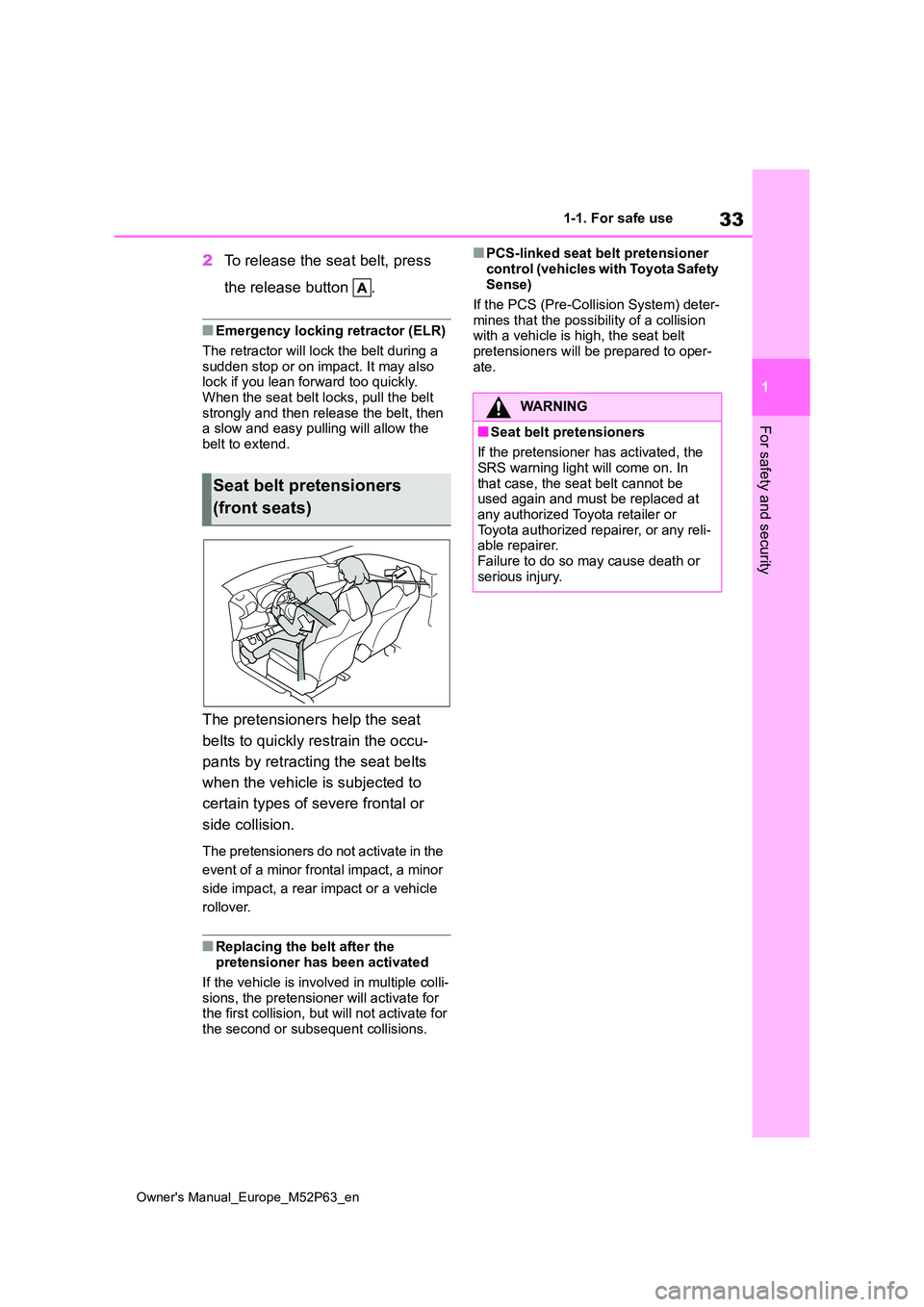
33
1
Owner's Manual_Europe_M52P63_en
1-1. For safe use
For safety and security
2To release the seat belt, press
the release button .
■Emergency locking retractor (ELR)
The retractor will lock the belt during a sudden stop or on impact. It may also lock if you lean forward too quickly.
When the seat belt locks, pull the belt strongly and then release the belt, then a slow and easy pulling will allow the
belt to extend.
The pretensioners help the seat
belts to quickly restrain the occu-
pants by retracting the seat belts
when the vehicle is subjected to
certain types of severe frontal or
side collision.
The pretensioners do not activate in the
event of a minor frontal impact, a minor
side impact, a rear impact or a vehicle
rollover.
■Replacing the belt after the pretensioner has been activated
If the vehicle is involved in multiple colli-
sions, the pretensioner will activate for the first collision, but will not activate for the second or subsequent collisions.
■PCS-linked seat belt pretensioner
control (vehicles with Toyota Safety Sense)
If the PCS (Pre-Collision System) deter-
mines that the possibility of a collision with a vehicle is high, the seat belt pretensioners will be prepared to oper-
ate.
Seat belt pretensioners
(front seats)
WARNING
■Seat belt pretensioners
If the pretensioner has activated, the
SRS warning light will come on. In that case, the seat belt cannot be used again and must be replaced at
any authorized Toyota retailer or Toyota authorized repairer, or any reli-able repairer.
Failure to do so may cause death or serious injury.
Page 36 of 470
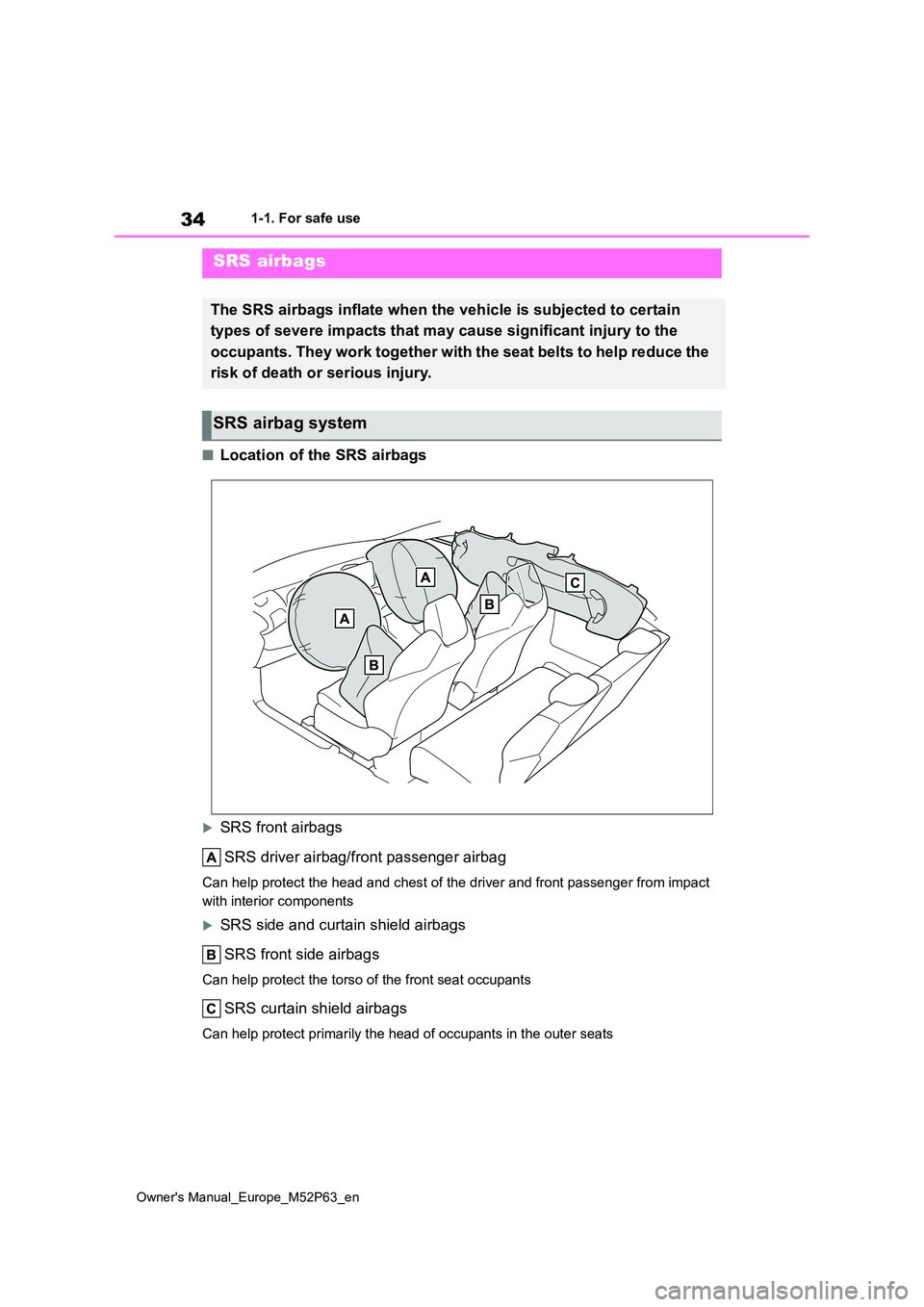
34
Owner's Manual_Europe_M52P63_en
1-1. For safe use
■Location of the SRS airbags
SRS front airbags
SRS driver airbag/front passenger airbag
Can help protect the head and chest of the driver and front pas senger from impact
with interior components
SRS side and curtain shield airbags
SRS front side airbags
Can help protect the torso of the front seat occupants
SRS curtain shield airbags
Can help protect primarily the head of occupants in the outer s eats
SRS airbags
The SRS airbags inflate when the vehicle is subjected to certain
types of severe impacts that may cause significant injury to th e
occupants. They work together with the seat belts to help reduc e the
risk of death or serious injury.
SRS airbag system
Page 37 of 470

35
1
Owner's Manual_Europe_M52P63_en
1-1. For safe use
For safety and security
■SRS airbag system components
Front impact sensors
Airbag manual on-off switch
Front passenger airbag
Side impact sensors (side door)
Side impact sensors (front)
Side airbags
Seat belt pretensioners and force limiters
Curtain shield airbags
Driver airbag
SRS warning light
“AIR BAG ON” and “AIR BAG OFF” indicator lights
Airbag sensor assembly
The main SRS airbag system components are shown above. The SRS air-
bag system is controlled by the airbag sensor assembly. As the airbags
deploy, a chemical reaction in the inflators quickly fills the airbags with non-
Page 38 of 470
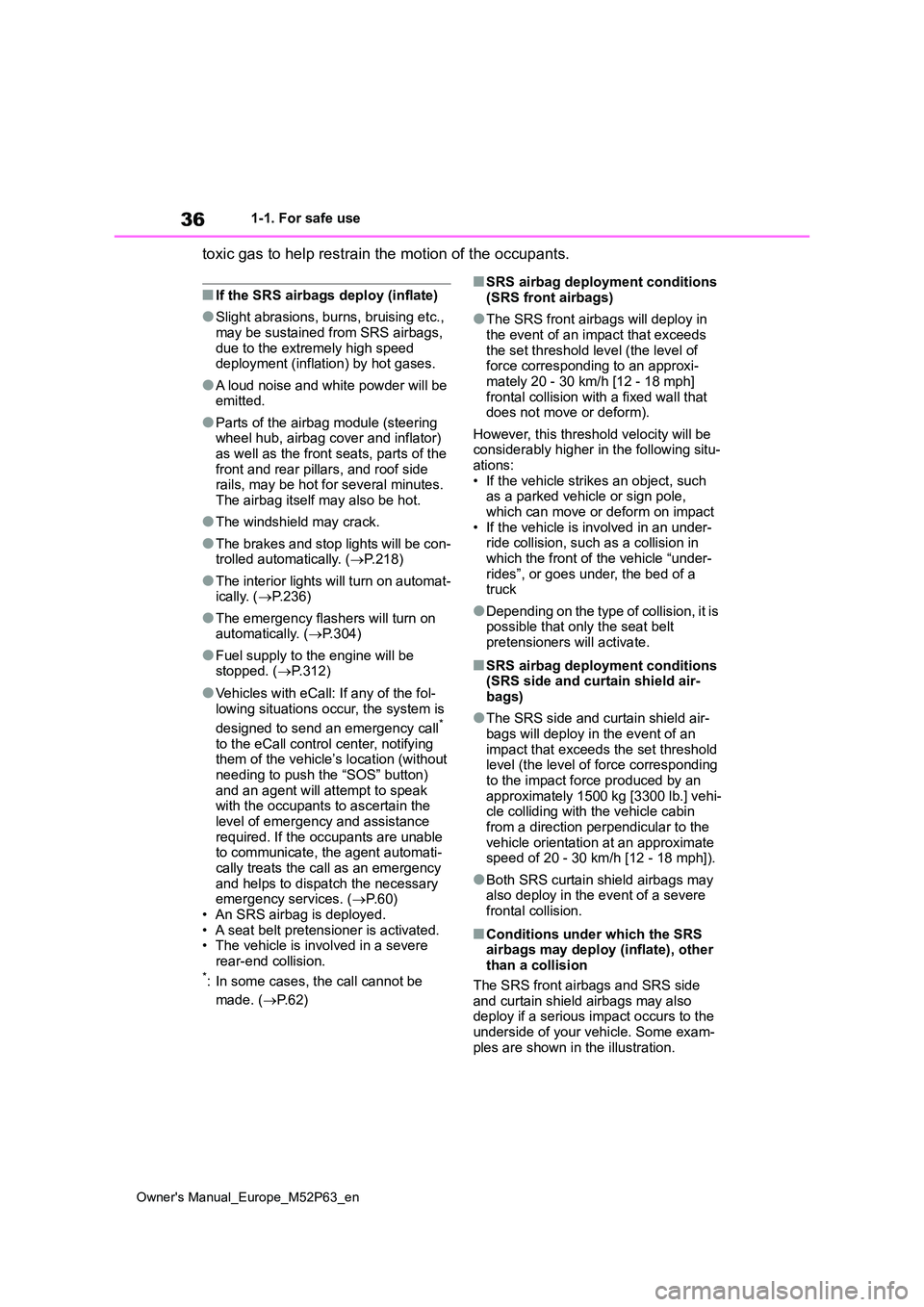
36
Owner's Manual_Europe_M52P63_en
1-1. For safe use
toxic gas to help restrain the motion of the occupants.
■If the SRS airbags deploy (inflate)
●Slight abrasions, burns, bruising etc., may be sustained from SRS airbags,
due to the extremely high speed deployment (inflation) by hot gases.
●A loud noise and white powder will be emitted.
●Parts of the airbag module (steering wheel hub, airbag cover and inflator) as well as the front seats, parts of the
front and rear pillars, and roof side rails, may be hot for several minutes. The airbag itself may also be hot.
●The windshield may crack.
●The brakes and stop lights will be con-trolled automatically. ( P.218)
●The interior lights will turn on automat- ically. ( P.236)
●The emergency flashers will turn on automatically. ( P.304)
●Fuel supply to the engine will be stopped. ( P.312)
●Vehicles with eCall: If any of the fol-
lowing situations occur, the system is
designed to send an emergency call*
to the eCall control center, notifying them of the vehicle’s location (without needing to push the “SOS” button)
and an agent will attempt to speak with the occupants to ascertain the
level of emergency and assistance required. If the occupants are unable to communicate, the agent automati-
cally treats the call as an emergency and helps to dispatch the necessary emergency services. ( P.60)
• An SRS airbag is deployed. • A seat belt pretensioner is activated.• The vehicle is involved in a severe
rear-end collision.*: In some cases, the call cannot be
made. ( P. 6 2 )
■SRS airbag deployment conditions
(SRS front airbags)
●The SRS front airbags will deploy in
the event of an impact that exceeds the set threshold level (the level of force corresponding to an approxi-
mately 20 - 30 km/h [12 - 18 mph] frontal collision with a fixed wall that does not move or deform).
However, this threshold velocity will be considerably higher in the following situ-
ations: • If the vehicle strikes an object, such as a parked vehicle or sign pole,
which can move or deform on impact • If the vehicle is involved in an under-ride collision, such as a collision in
which the front of the vehicle “under- rides”, or goes under, the bed of a truck
●Depending on the type of collision, it is possible that only the seat belt
pretensioners will activate.
■SRS airbag deployment conditions (SRS side and curtain shield air-bags)
●The SRS side and curtain shield air-bags will deploy in the event of an
impact that exceeds the set threshold level (the level of force corresponding to the impact force produced by an
approximately 1500 kg [3300 lb.] vehi- cle colliding with the vehicle cabin from a direction perpendicular to the
vehicle orientation at an approximate speed of 20 - 30 km/h [12 - 18 mph]).
●Both SRS curtain shield airbags may also deploy in the event of a severe frontal collision.
■Conditions under which the SRS airbags may deploy (inflate), other than a collision
The SRS front airbags and SRS side and curtain shield airbags may also deploy if a serious impact occurs to the
underside of your vehicle. Some exam- ples are shown in the illustration.
Page 40 of 470
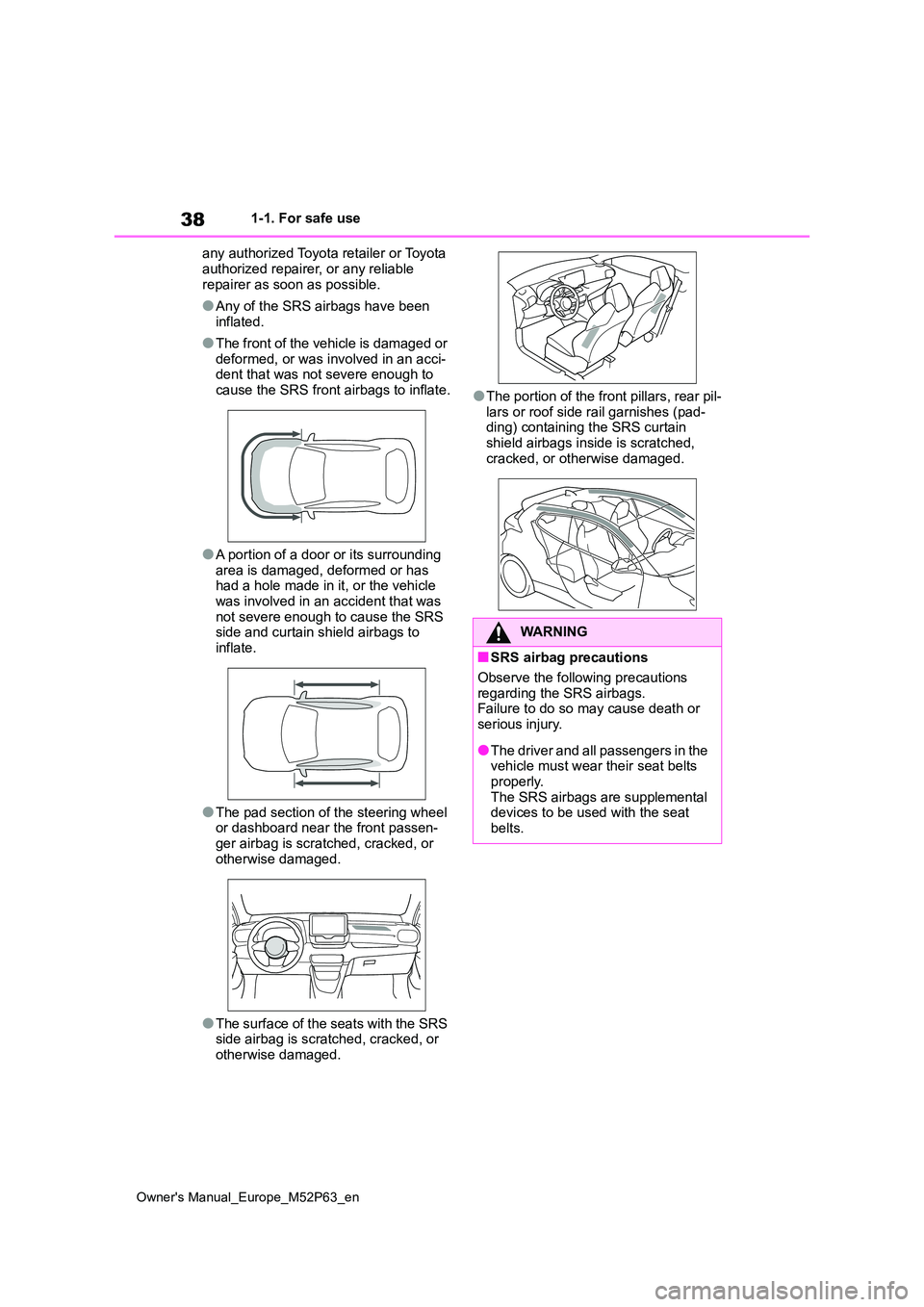
38
Owner's Manual_Europe_M52P63_en
1-1. For safe use
any authorized Toyota retailer or Toyota
authorized repairer, or any reliable repairer as soon as possible.
●Any of the SRS airbags have been inflated.
●The front of the vehicle is damaged or deformed, or was involved in an acci-dent that was not severe enough to
cause the SRS front airbags to inflate.
●A portion of a door or its surrounding
area is damaged, deformed or has had a hole made in it, or the vehicle was involved in an accident that was
not severe enough to cause the SRS side and curtain shield airbags to inflate.
●The pad section of the steering wheel or dashboard near the front passen-
ger airbag is scratched, cracked, or otherwise damaged.
●The surface of the seats with the SRS side airbag is scratched, cracked, or otherwise damaged.
●The portion of the front pillars, rear pil-
lars or roof side rail garnishes (pad- ding) containing the SRS curtain shield airbags inside is scratched,
cracked, or otherwise damaged.
WARNING
■SRS airbag precautions
Observe the following precautions
regarding the SRS airbags. Failure to do so may cause death or serious injury.
●The driver and all passengers in the vehicle must wear their seat belts
properly. The SRS airbags are supplemental devices to be used with the seat
belts.
Page 41 of 470
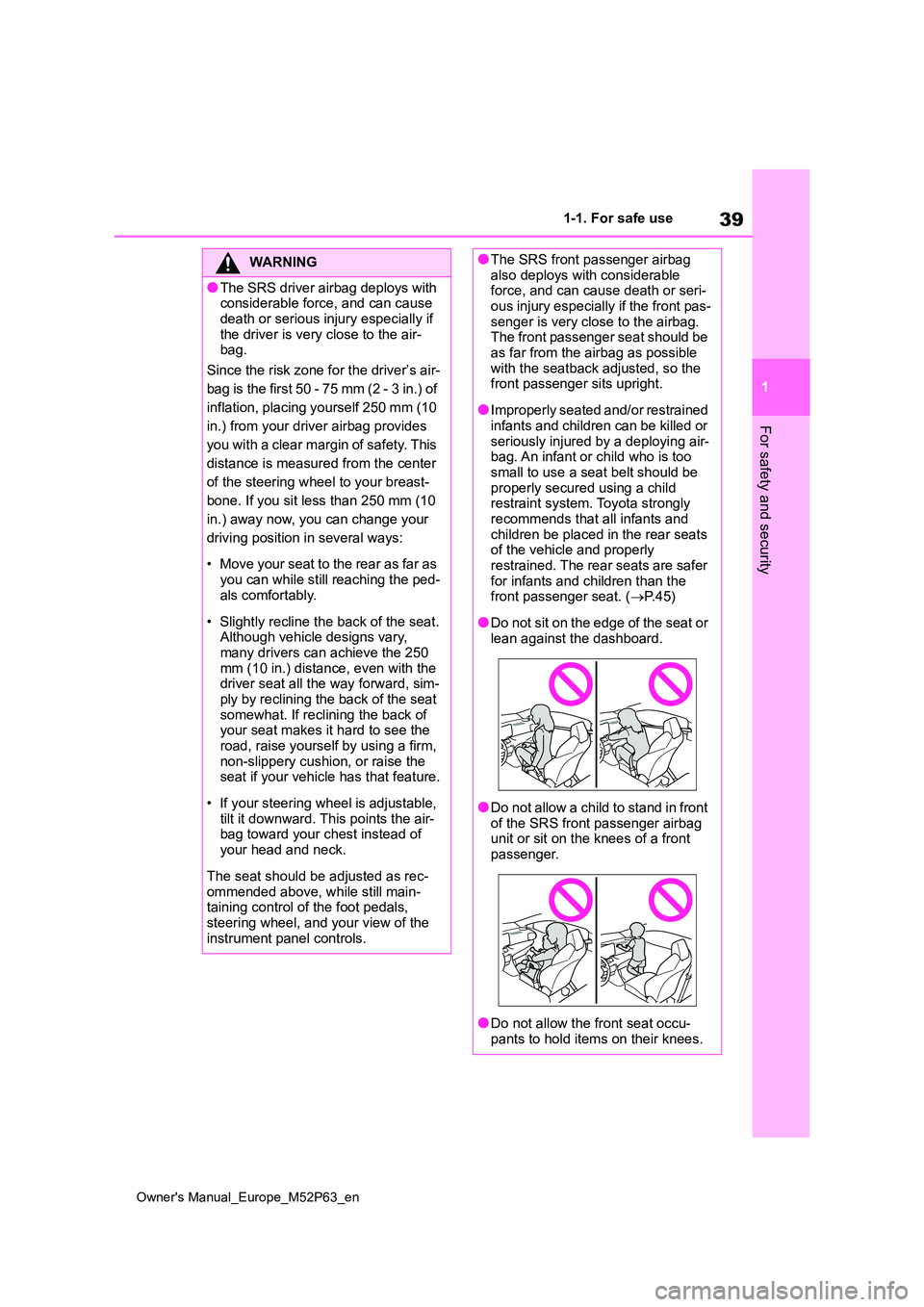
39
1
Owner's Manual_Europe_M52P63_en
1-1. For safe use
For safety and security
WARNING
●The SRS driver airbag deploys with considerable force, and can cause
death or serious injury especially if the driver is very close to the air-bag.
Since the risk zone for the driver’s air-
bag is the first 50 - 75 mm (2 - 3 in.) of
inflation, placing yourself 250 mm (10
in.) from your driver airbag provides
you with a clear margin of safety. This
distance is measured from the center
of the steering wheel to your breast-
bone. If you sit less than 250 mm (10
in.) away now, you can change your
driving position in several ways:
• Move your seat to the rear as far as
you can while still reaching the ped- als comfortably.
• Slightly recline the back of the seat. Although vehicle designs vary, many drivers can achieve the 250
mm (10 in.) distance, even with the driver seat all the way forward, sim-ply by reclining the back of the seat
somewhat. If reclining the back of your seat makes it hard to see the road, raise yourself by using a firm,
non-slippery cushion, or raise the seat if your vehicle has that feature.
• If your steering wheel is adjustable, tilt it downward. This points the air-bag toward your chest instead of
your head and neck.
The seat should be adjusted as rec-
ommended above, while still main- taining control of the foot pedals, steering wheel, and your view of the
instrument panel controls.
●The SRS front passenger airbag also deploys with considerable force, and can cause death or seri-
ous injury especially if the front pas- senger is very close to the airbag. The front passenger seat should be
as far from the airbag as possible with the seatback adjusted, so the front passenger sits upright.
●Improperly seated and/or restrained infants and children can be killed or
seriously injured by a deploying air- bag. An infant or child who is too small to use a seat belt should be
properly secured using a child restraint system. Toyota strongly recommends that all infants and
children be placed in the rear seats of the vehicle and properly restrained. The rear seats are safer
for infants and children than the front passenger seat. ( P. 4 5 )
●Do not sit on the edge of the seat or lean against the dashboard.
●Do not allow a child to stand in front of the SRS front passenger airbag unit or sit on the knees of a front
passenger.
●Do not allow the front seat occu-
pants to hold items on their knees.